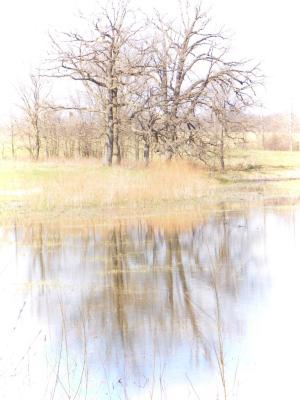| General Poetry posted January 22, 2015 | Chapters: |
...202 203 -204- 205... 
|
      |
A Roundelay
A chapter in the book Little Poems
Season of Starkness
by Treischel
|
 Recognized |
Every season has its own unique beauty. Here I focus on early spring, just after the snow has gone, but before the leaves and plants have budded. The element here is Starkness. But even here, there is a raw elegance and the promise of renewal within those unadorned, naked limbs of trees and the faded grasses and dorment seeds.
This poem is an Roundelay.
The roundelay is an English repeating format. As a fixed stanzaic form, the English poet John Dryden, 1631-1700, created a two rhyme, repetition of lines in a set pattern that is recognized as the Roundelay. It consists of 24 lines in four sets of sestets (6 line stanzas) with a fixed format. The meter is often written in trochaic tetrameter with some of the lines catalectic (one syllable short) to create a strong end rhyme. Only 2 rhymes are used throughout the poem yielding an alternating rhyme scheme of:
ababab
in each stanza.
However, there are two key features about the format. First of all, the 5th and 6th lines repeat in every stanza, providing a strong echoing sentiment. Secondly, the 3rd and 4th lines of each stanza become the first and second line of the next stanza, creating a wonderful waterfall cascading effect. So the the trick is to blend everything to create a smooth story or thematic flow. This all results in the following rhyme scheme:
Stanza 1: a b A1 B1 A2 B2
Stanza 2: A1 B1 A3 B3 A2 B2
Stanza 3: A3 B3 A4 B4 A2 B2
Stanza 4: A4 B4 a b A2 B2
where the capital letters represent repeated lines, and the numbers represent the repetition sequence.
For this poem I did use the 8-7 meter option. I also resoreted to near rhyme in several places.
This photograph was taken by the author at Lake Elmo Park Reserve in May, 2012.
Pays
one point
and 2 member cents. This poem is an Roundelay.
The roundelay is an English repeating format. As a fixed stanzaic form, the English poet John Dryden, 1631-1700, created a two rhyme, repetition of lines in a set pattern that is recognized as the Roundelay. It consists of 24 lines in four sets of sestets (6 line stanzas) with a fixed format. The meter is often written in trochaic tetrameter with some of the lines catalectic (one syllable short) to create a strong end rhyme. Only 2 rhymes are used throughout the poem yielding an alternating rhyme scheme of:
ababab
in each stanza.
However, there are two key features about the format. First of all, the 5th and 6th lines repeat in every stanza, providing a strong echoing sentiment. Secondly, the 3rd and 4th lines of each stanza become the first and second line of the next stanza, creating a wonderful waterfall cascading effect. So the the trick is to blend everything to create a smooth story or thematic flow. This all results in the following rhyme scheme:
Stanza 1: a b A1 B1 A2 B2
Stanza 2: A1 B1 A3 B3 A2 B2
Stanza 3: A3 B3 A4 B4 A2 B2
Stanza 4: A4 B4 a b A2 B2
where the capital letters represent repeated lines, and the numbers represent the repetition sequence.
For this poem I did use the 8-7 meter option. I also resoreted to near rhyme in several places.
This photograph was taken by the author at Lake Elmo Park Reserve in May, 2012.

You need to login or register to write reviews. It's quick! We only ask four questions to new members.
© Copyright 2024. Treischel All rights reserved.
Treischel has granted FanStory.com, its affiliates and its syndicates non-exclusive rights to display this work.


